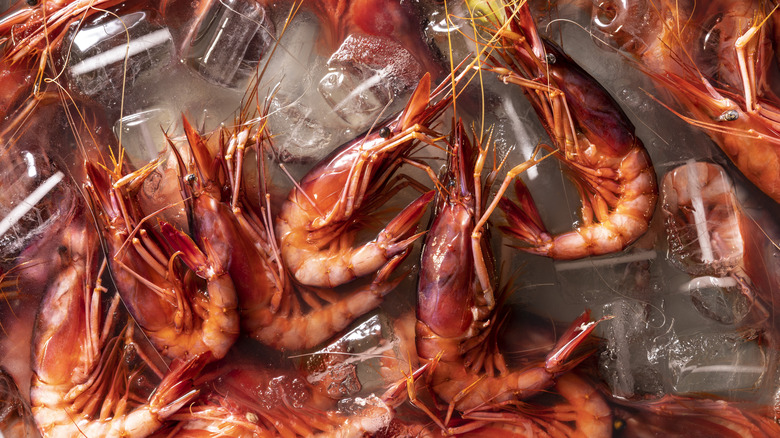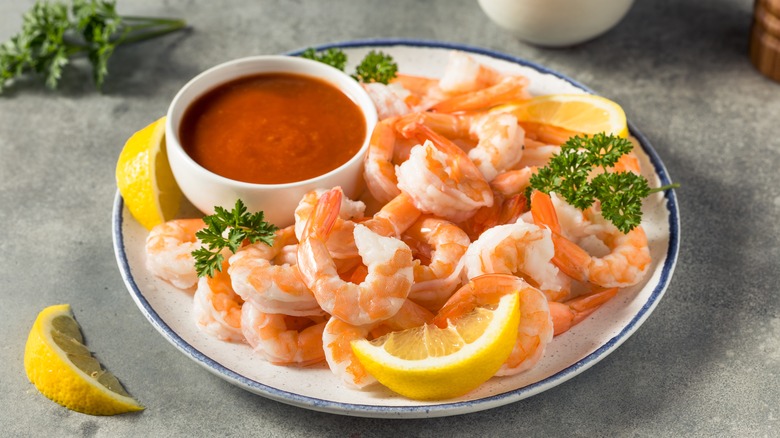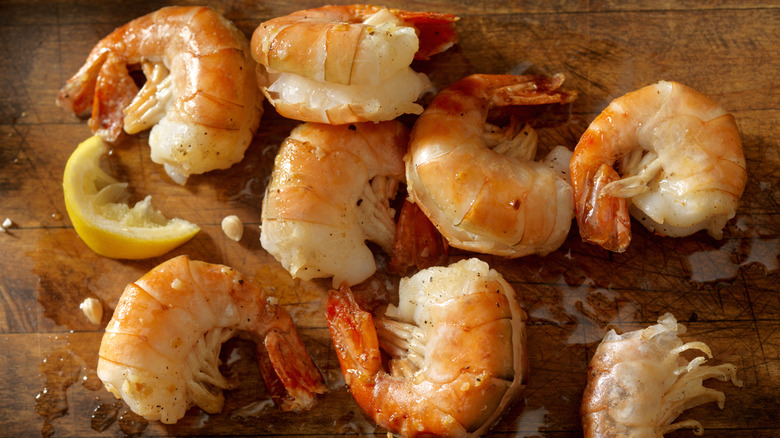Why It's A Mistake To Buy 'Fresh' Shrimp From The Grocery Store
Some foods are better fresh instead of frozen, but that's not typically the case with shrimp. While it's natural to assume that the raw kind at your grocery store fish counter is the best choice for the tastiest seafood, unless you are buying those crustaceans straight off the boat, you'll want to opt for the frozen ones.
To understand why frozen is the better option, it's helpful to know a bit about how shrimp are preserved after they're caught. Almost all shrimp sold has been frozen, it's mostly a matter of when. The sooner it is frozen after being pulled from the water, the fresher tasting the shrimp will be. Most are immediately flash-frozen right on the boat to preserve their freshness and can be individually quick frozen or block frozen. The frozen shrimp sold in grocery stores are usually individually quick frozen and packaged in bags, making it easy to grab the exact amount needed for cooking.
The shrimp you see at the seafood counter at your local grocer has likely been frozen and thawed. Although it might look like or be labeled as "fresh shrimp," it's actually becoming less fresh the longer it sits and thaws. So, skip the seafood counter and follow a few other helpful tips for the best-tasting shrimp possible.
Sources and types of shrimp
Some argue that wild-caught shrimp, which have been caught in their natural environment, have a higher quality and better taste and texture than the farmed-raised kind due to their natural diet and absence of chemicals or antibiotics. However, farm-raised shrimp are generally more affordable and available year-round and may be more consistent in texture and taste. No matter whether you buy wild-caught or farm-raised, you can ensure your shrimp are ethically caught/raised by looking for sustainability labels from trusted organizations such as the Marine Stewardship Council or the Aquaculture Stewardship Council.
There are countless types of shrimp in the wild, but the most commonly eaten varieties include brown shrimp, pink shrimp, white shrimp, rock shrimp, tiger shrimp, and royal red shrimp. The brown, white, and pink varieties are milder in taste and ubiquitous in grocery stores; rock shrimp have a similar flavor to lobster without the high price tag; tiger shrimp are quite large in size and harder to find in the U.S., and royal red shrimp are highly sought after for their tastiness and tenderness.
Avoid shrimp cooking mistakes like choosing the wrong size for your recipe. Smaller ones tend to work better for salads, while jumbo shrimp are great for dunking into cocktail sauce. And, in case you were wondering, yes, there's a difference between shrimp and prawns. Generally, prawns are larger, a tad more expensive, and found only in fresh water.
Shell-on shrimp vs shell-off
A common question many shrimp-shoppers have is whether to buy them with the shell on or off. They can be packaged with the shell entirely on, ready to peel, or with the shells completely removed.
Shell-on shrimp are often recommended because they're less expensive and the shell helps maintain the meat's integrity. The shells also add concentrated flavor and can be boiled to make a tasty stock. The downside is that they take longer to clean and devein. On the plus side, you might find roe while cleaning shrimp.
If you'd rather avoid the time-consuming task of deveining, you can pay a bit more for shrimp that have been split and cleaned. These kind can be cooked with the shell on and served to guests to peel and eat. Or, you can easily peel them yourself to use them for shrimp cocktail.
Shrimp that have been completely shelled are a great choice if you plan to cook them in a pasta dish or stir fry. However, pre-peeled shrimp tend to be over-handled and may not have the best appearance or texture for a shrimp cocktail. They are also the more expensive option since the work has been done for you. Whether you choose shell-on or off ultimately boils down to personal preference; just remember to buy frozen for the tastiest shrimp.


